University Nursing Report: Lower Urinary Tract Infection Case Study
VerifiedAdded on 2020/05/28
|25
|6970
|647
Report
AI Summary
This report presents a detailed case study of Queenie Jacobs, a 73-year-old woman admitted to the hospital with a lower urinary tract infection (UTI) caused by Escherichia coli. The report explores the pathophysiology of UTIs, including the role of E. coli, signs and symptoms such as dysuria, frequent urination, and confusion, and associated risk factors like post-menopause. It also covers potential complications, such as kidney infection and sepsis, and outlines a nursing care plan that includes interventions for impaired urinary elimination, acute pain, and hyperthermia. The pharmacology of the prescribed medication, co-amoxiclav, is discussed, including its pharmacodynamic and pharmacokinetic principles, side effects, and medication management standards. The report highlights the importance of understanding antibiotic resistance in managing UTIs and provides a comprehensive overview of the patient's condition and treatment.

Running head: LOWER URINARY TRACT INFECTION
LOWER URINARY TRACT INFECTION
Name of the Student
Name of the University
Author Notes
LOWER URINARY TRACT INFECTION
Name of the Student
Name of the University
Author Notes
Paraphrase This Document
Need a fresh take? Get an instant paraphrase of this document with our AI Paraphraser
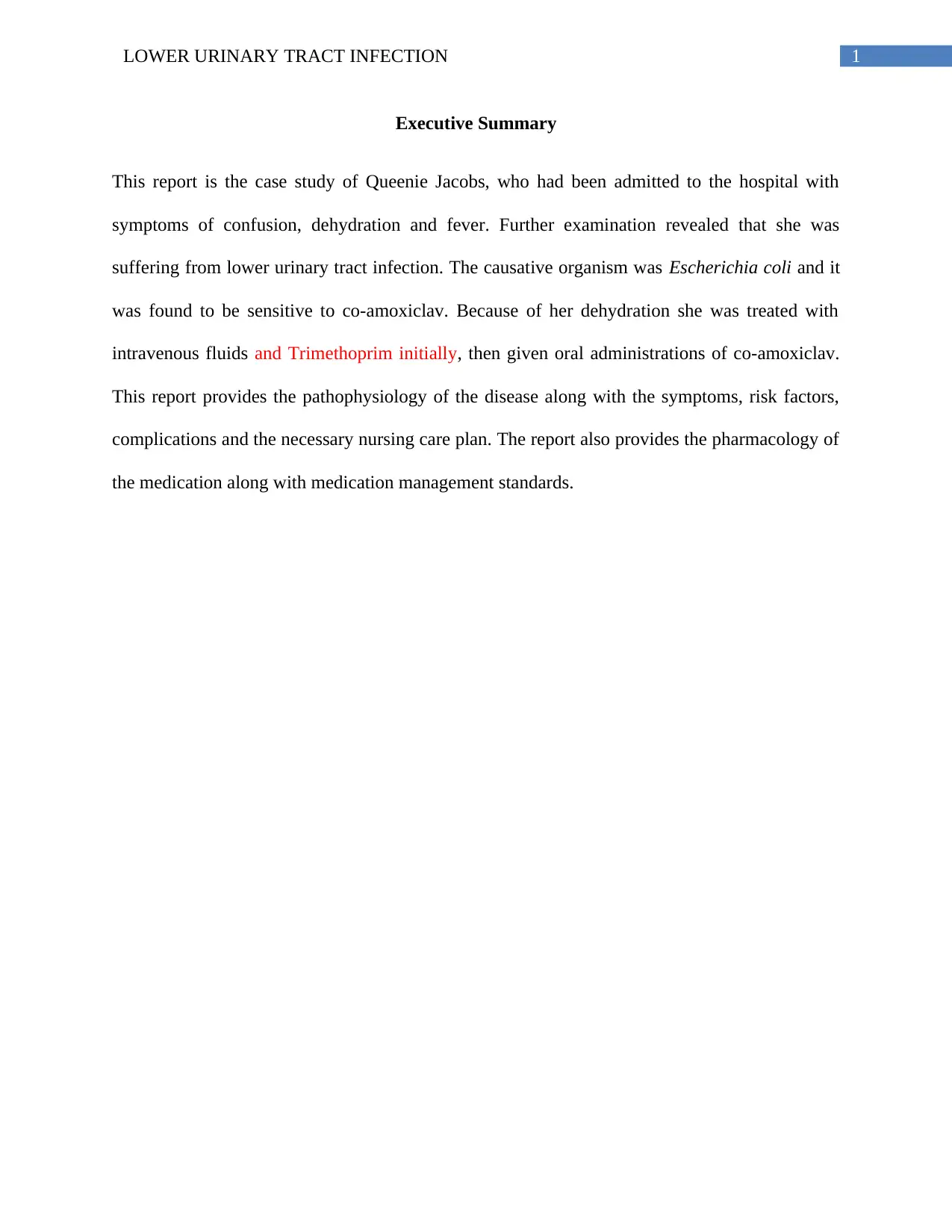
1LOWER URINARY TRACT INFECTION
Executive Summary
This report is the case study of Queenie Jacobs, who had been admitted to the hospital with
symptoms of confusion, dehydration and fever. Further examination revealed that she was
suffering from lower urinary tract infection. The causative organism was Escherichia coli and it
was found to be sensitive to co-amoxiclav. Because of her dehydration she was treated with
intravenous fluids and Trimethoprim initially, then given oral administrations of co-amoxiclav.
This report provides the pathophysiology of the disease along with the symptoms, risk factors,
complications and the necessary nursing care plan. The report also provides the pharmacology of
the medication along with medication management standards.
Executive Summary
This report is the case study of Queenie Jacobs, who had been admitted to the hospital with
symptoms of confusion, dehydration and fever. Further examination revealed that she was
suffering from lower urinary tract infection. The causative organism was Escherichia coli and it
was found to be sensitive to co-amoxiclav. Because of her dehydration she was treated with
intravenous fluids and Trimethoprim initially, then given oral administrations of co-amoxiclav.
This report provides the pathophysiology of the disease along with the symptoms, risk factors,
complications and the necessary nursing care plan. The report also provides the pharmacology of
the medication along with medication management standards.

2LOWER URINARY TRACT INFECTION
Table of Contents
Lower urinary tract infection...........................................................................................................4
Pathophysiology of lower urinary tract infection............................................................................5
Signs and symptoms........................................................................................................................6
Association of E. coli with urinary tract infections.........................................................................6
Complications of urinary tract infections........................................................................................8
Nursing care for urinary tract infections..........................................................................................8
Pharmacodynamic and pharmacokinetic principles of Co-amoxiclav..........................................10
Side effects of the drug..................................................................................................................13
Antibiotic Resistance.....................................................................................................................14
Medication management................................................................................................................14
Conclusion.....................................................................................................................................15
Reference List................................................................................................................................17
Table of Contents
Lower urinary tract infection...........................................................................................................4
Pathophysiology of lower urinary tract infection............................................................................5
Signs and symptoms........................................................................................................................6
Association of E. coli with urinary tract infections.........................................................................6
Complications of urinary tract infections........................................................................................8
Nursing care for urinary tract infections..........................................................................................8
Pharmacodynamic and pharmacokinetic principles of Co-amoxiclav..........................................10
Side effects of the drug..................................................................................................................13
Antibiotic Resistance.....................................................................................................................14
Medication management................................................................................................................14
Conclusion.....................................................................................................................................15
Reference List................................................................................................................................17
⊘ This is a preview!⊘
Do you want full access?
Subscribe today to unlock all pages.

Trusted by 1+ million students worldwide
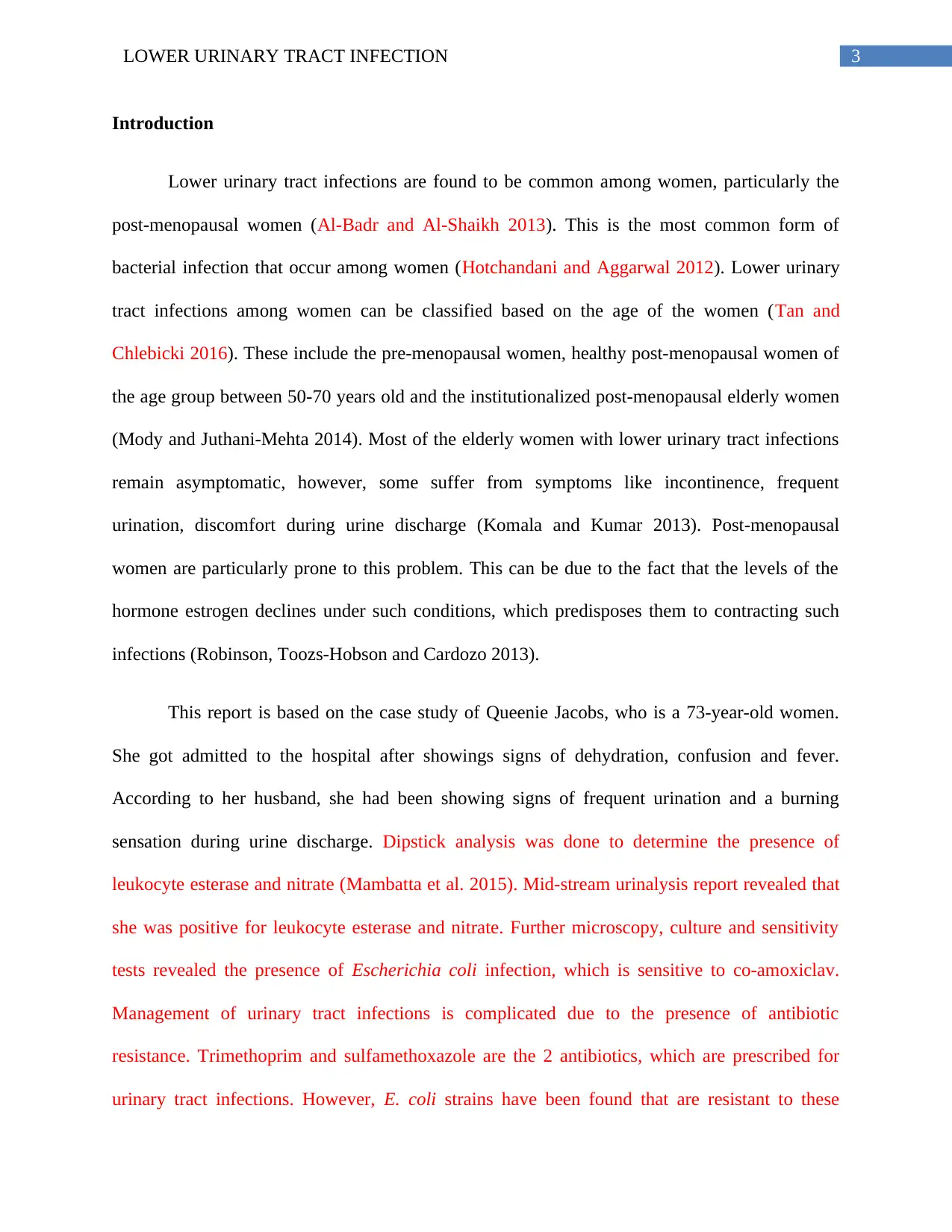
3LOWER URINARY TRACT INFECTION
Introduction
Lower urinary tract infections are found to be common among women, particularly the
post-menopausal women (Al-Badr and Al-Shaikh 2013). This is the most common form of
bacterial infection that occur among women (Hotchandani and Aggarwal 2012). Lower urinary
tract infections among women can be classified based on the age of the women (Tan and
Chlebicki 2016). These include the pre-menopausal women, healthy post-menopausal women of
the age group between 50-70 years old and the institutionalized post-menopausal elderly women
(Mody and Juthani-Mehta 2014). Most of the elderly women with lower urinary tract infections
remain asymptomatic, however, some suffer from symptoms like incontinence, frequent
urination, discomfort during urine discharge (Komala and Kumar 2013). Post-menopausal
women are particularly prone to this problem. This can be due to the fact that the levels of the
hormone estrogen declines under such conditions, which predisposes them to contracting such
infections (Robinson, Toozs-Hobson and Cardozo 2013).
This report is based on the case study of Queenie Jacobs, who is a 73-year-old women.
She got admitted to the hospital after showings signs of dehydration, confusion and fever.
According to her husband, she had been showing signs of frequent urination and a burning
sensation during urine discharge. Dipstick analysis was done to determine the presence of
leukocyte esterase and nitrate (Mambatta et al. 2015). Mid-stream urinalysis report revealed that
she was positive for leukocyte esterase and nitrate. Further microscopy, culture and sensitivity
tests revealed the presence of Escherichia coli infection, which is sensitive to co-amoxiclav.
Management of urinary tract infections is complicated due to the presence of antibiotic
resistance. Trimethoprim and sulfamethoxazole are the 2 antibiotics, which are prescribed for
urinary tract infections. However, E. coli strains have been found that are resistant to these
Introduction
Lower urinary tract infections are found to be common among women, particularly the
post-menopausal women (Al-Badr and Al-Shaikh 2013). This is the most common form of
bacterial infection that occur among women (Hotchandani and Aggarwal 2012). Lower urinary
tract infections among women can be classified based on the age of the women (Tan and
Chlebicki 2016). These include the pre-menopausal women, healthy post-menopausal women of
the age group between 50-70 years old and the institutionalized post-menopausal elderly women
(Mody and Juthani-Mehta 2014). Most of the elderly women with lower urinary tract infections
remain asymptomatic, however, some suffer from symptoms like incontinence, frequent
urination, discomfort during urine discharge (Komala and Kumar 2013). Post-menopausal
women are particularly prone to this problem. This can be due to the fact that the levels of the
hormone estrogen declines under such conditions, which predisposes them to contracting such
infections (Robinson, Toozs-Hobson and Cardozo 2013).
This report is based on the case study of Queenie Jacobs, who is a 73-year-old women.
She got admitted to the hospital after showings signs of dehydration, confusion and fever.
According to her husband, she had been showing signs of frequent urination and a burning
sensation during urine discharge. Dipstick analysis was done to determine the presence of
leukocyte esterase and nitrate (Mambatta et al. 2015). Mid-stream urinalysis report revealed that
she was positive for leukocyte esterase and nitrate. Further microscopy, culture and sensitivity
tests revealed the presence of Escherichia coli infection, which is sensitive to co-amoxiclav.
Management of urinary tract infections is complicated due to the presence of antibiotic
resistance. Trimethoprim and sulfamethoxazole are the 2 antibiotics, which are prescribed for
urinary tract infections. However, E. coli strains have been found that are resistant to these
Paraphrase This Document
Need a fresh take? Get an instant paraphrase of this document with our AI Paraphraser
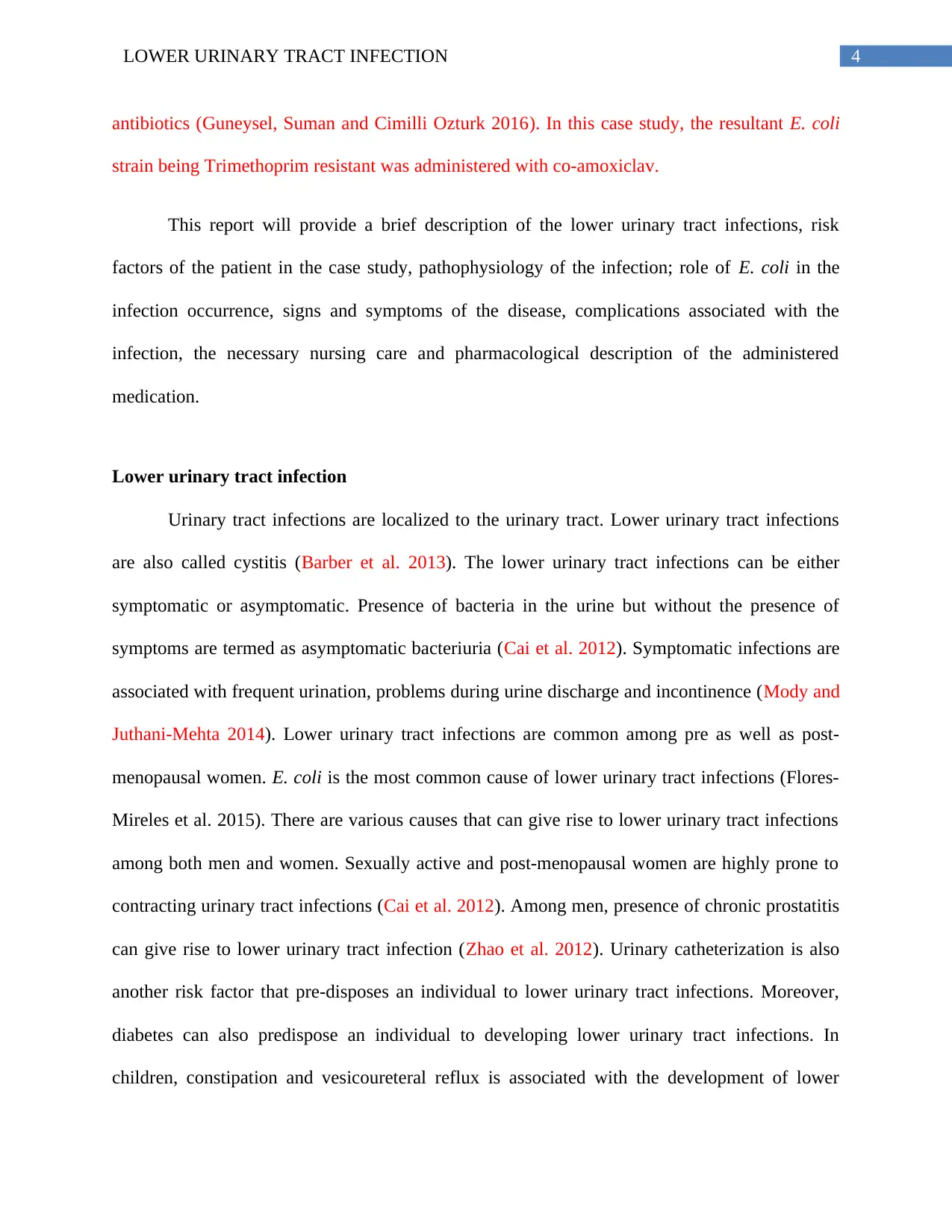
4LOWER URINARY TRACT INFECTION
antibiotics (Guneysel, Suman and Cimilli Ozturk 2016). In this case study, the resultant E. coli
strain being Trimethoprim resistant was administered with co-amoxiclav.
This report will provide a brief description of the lower urinary tract infections, risk
factors of the patient in the case study, pathophysiology of the infection; role of E. coli in the
infection occurrence, signs and symptoms of the disease, complications associated with the
infection, the necessary nursing care and pharmacological description of the administered
medication.
Lower urinary tract infection
Urinary tract infections are localized to the urinary tract. Lower urinary tract infections
are also called cystitis (Barber et al. 2013). The lower urinary tract infections can be either
symptomatic or asymptomatic. Presence of bacteria in the urine but without the presence of
symptoms are termed as asymptomatic bacteriuria (Cai et al. 2012). Symptomatic infections are
associated with frequent urination, problems during urine discharge and incontinence (Mody and
Juthani-Mehta 2014). Lower urinary tract infections are common among pre as well as post-
menopausal women. E. coli is the most common cause of lower urinary tract infections (Flores-
Mireles et al. 2015). There are various causes that can give rise to lower urinary tract infections
among both men and women. Sexually active and post-menopausal women are highly prone to
contracting urinary tract infections (Cai et al. 2012). Among men, presence of chronic prostatitis
can give rise to lower urinary tract infection (Zhao et al. 2012). Urinary catheterization is also
another risk factor that pre-disposes an individual to lower urinary tract infections. Moreover,
diabetes can also predispose an individual to developing lower urinary tract infections. In
children, constipation and vesicoureteral reflux is associated with the development of lower
antibiotics (Guneysel, Suman and Cimilli Ozturk 2016). In this case study, the resultant E. coli
strain being Trimethoprim resistant was administered with co-amoxiclav.
This report will provide a brief description of the lower urinary tract infections, risk
factors of the patient in the case study, pathophysiology of the infection; role of E. coli in the
infection occurrence, signs and symptoms of the disease, complications associated with the
infection, the necessary nursing care and pharmacological description of the administered
medication.
Lower urinary tract infection
Urinary tract infections are localized to the urinary tract. Lower urinary tract infections
are also called cystitis (Barber et al. 2013). The lower urinary tract infections can be either
symptomatic or asymptomatic. Presence of bacteria in the urine but without the presence of
symptoms are termed as asymptomatic bacteriuria (Cai et al. 2012). Symptomatic infections are
associated with frequent urination, problems during urine discharge and incontinence (Mody and
Juthani-Mehta 2014). Lower urinary tract infections are common among pre as well as post-
menopausal women. E. coli is the most common cause of lower urinary tract infections (Flores-
Mireles et al. 2015). There are various causes that can give rise to lower urinary tract infections
among both men and women. Sexually active and post-menopausal women are highly prone to
contracting urinary tract infections (Cai et al. 2012). Among men, presence of chronic prostatitis
can give rise to lower urinary tract infection (Zhao et al. 2012). Urinary catheterization is also
another risk factor that pre-disposes an individual to lower urinary tract infections. Moreover,
diabetes can also predispose an individual to developing lower urinary tract infections. In
children, constipation and vesicoureteral reflux is associated with the development of lower
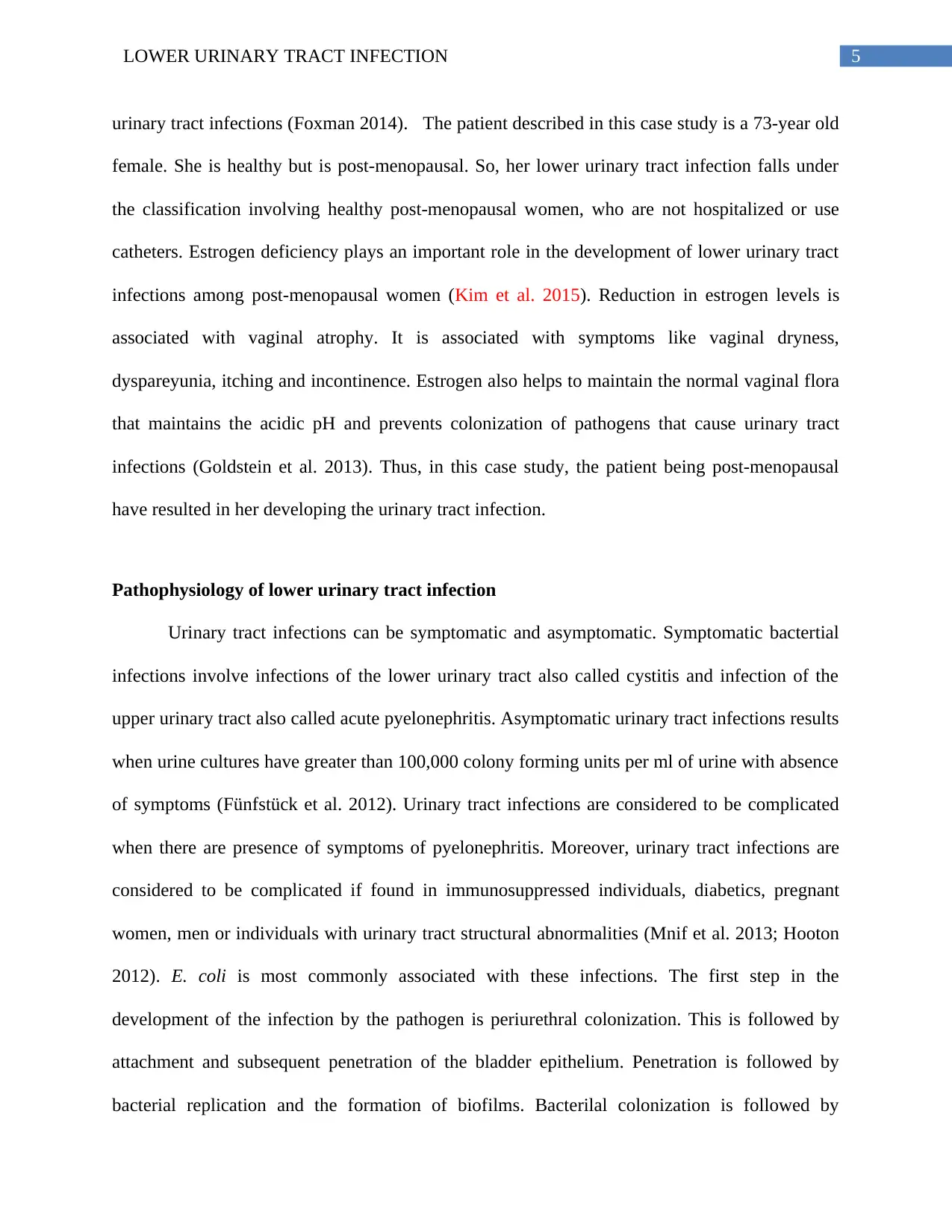
5LOWER URINARY TRACT INFECTION
urinary tract infections (Foxman 2014). The patient described in this case study is a 73-year old
female. She is healthy but is post-menopausal. So, her lower urinary tract infection falls under
the classification involving healthy post-menopausal women, who are not hospitalized or use
catheters. Estrogen deficiency plays an important role in the development of lower urinary tract
infections among post-menopausal women (Kim et al. 2015). Reduction in estrogen levels is
associated with vaginal atrophy. It is associated with symptoms like vaginal dryness,
dyspareyunia, itching and incontinence. Estrogen also helps to maintain the normal vaginal flora
that maintains the acidic pH and prevents colonization of pathogens that cause urinary tract
infections (Goldstein et al. 2013). Thus, in this case study, the patient being post-menopausal
have resulted in her developing the urinary tract infection.
Pathophysiology of lower urinary tract infection
Urinary tract infections can be symptomatic and asymptomatic. Symptomatic bactertial
infections involve infections of the lower urinary tract also called cystitis and infection of the
upper urinary tract also called acute pyelonephritis. Asymptomatic urinary tract infections results
when urine cultures have greater than 100,000 colony forming units per ml of urine with absence
of symptoms (Fünfstück et al. 2012). Urinary tract infections are considered to be complicated
when there are presence of symptoms of pyelonephritis. Moreover, urinary tract infections are
considered to be complicated if found in immunosuppressed individuals, diabetics, pregnant
women, men or individuals with urinary tract structural abnormalities (Mnif et al. 2013; Hooton
2012). E. coli is most commonly associated with these infections. The first step in the
development of the infection by the pathogen is periurethral colonization. This is followed by
attachment and subsequent penetration of the bladder epithelium. Penetration is followed by
bacterial replication and the formation of biofilms. Bacterilal colonization is followed by
urinary tract infections (Foxman 2014). The patient described in this case study is a 73-year old
female. She is healthy but is post-menopausal. So, her lower urinary tract infection falls under
the classification involving healthy post-menopausal women, who are not hospitalized or use
catheters. Estrogen deficiency plays an important role in the development of lower urinary tract
infections among post-menopausal women (Kim et al. 2015). Reduction in estrogen levels is
associated with vaginal atrophy. It is associated with symptoms like vaginal dryness,
dyspareyunia, itching and incontinence. Estrogen also helps to maintain the normal vaginal flora
that maintains the acidic pH and prevents colonization of pathogens that cause urinary tract
infections (Goldstein et al. 2013). Thus, in this case study, the patient being post-menopausal
have resulted in her developing the urinary tract infection.
Pathophysiology of lower urinary tract infection
Urinary tract infections can be symptomatic and asymptomatic. Symptomatic bactertial
infections involve infections of the lower urinary tract also called cystitis and infection of the
upper urinary tract also called acute pyelonephritis. Asymptomatic urinary tract infections results
when urine cultures have greater than 100,000 colony forming units per ml of urine with absence
of symptoms (Fünfstück et al. 2012). Urinary tract infections are considered to be complicated
when there are presence of symptoms of pyelonephritis. Moreover, urinary tract infections are
considered to be complicated if found in immunosuppressed individuals, diabetics, pregnant
women, men or individuals with urinary tract structural abnormalities (Mnif et al. 2013; Hooton
2012). E. coli is most commonly associated with these infections. The first step in the
development of the infection by the pathogen is periurethral colonization. This is followed by
attachment and subsequent penetration of the bladder epithelium. Penetration is followed by
bacterial replication and the formation of biofilms. Bacterilal colonization is followed by
⊘ This is a preview!⊘
Do you want full access?
Subscribe today to unlock all pages.

Trusted by 1+ million students worldwide
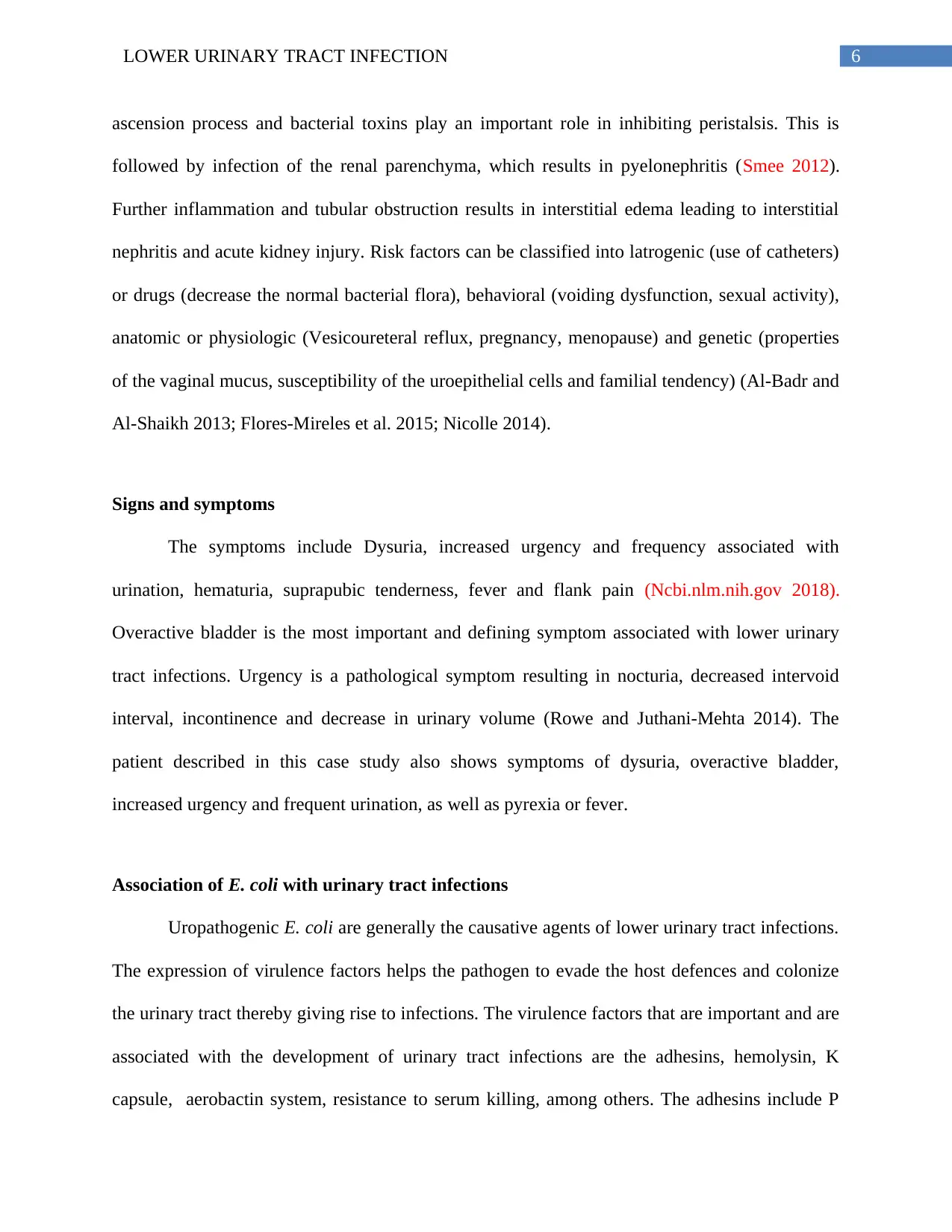
6LOWER URINARY TRACT INFECTION
ascension process and bacterial toxins play an important role in inhibiting peristalsis. This is
followed by infection of the renal parenchyma, which results in pyelonephritis (Smee 2012).
Further inflammation and tubular obstruction results in interstitial edema leading to interstitial
nephritis and acute kidney injury. Risk factors can be classified into latrogenic (use of catheters)
or drugs (decrease the normal bacterial flora), behavioral (voiding dysfunction, sexual activity),
anatomic or physiologic (Vesicoureteral reflux, pregnancy, menopause) and genetic (properties
of the vaginal mucus, susceptibility of the uroepithelial cells and familial tendency) (Al-Badr and
Al-Shaikh 2013; Flores-Mireles et al. 2015; Nicolle 2014).
Signs and symptoms
The symptoms include Dysuria, increased urgency and frequency associated with
urination, hematuria, suprapubic tenderness, fever and flank pain (Ncbi.nlm.nih.gov 2018).
Overactive bladder is the most important and defining symptom associated with lower urinary
tract infections. Urgency is a pathological symptom resulting in nocturia, decreased intervoid
interval, incontinence and decrease in urinary volume (Rowe and Juthani-Mehta 2014). The
patient described in this case study also shows symptoms of dysuria, overactive bladder,
increased urgency and frequent urination, as well as pyrexia or fever.
Association of E. coli with urinary tract infections
Uropathogenic E. coli are generally the causative agents of lower urinary tract infections.
The expression of virulence factors helps the pathogen to evade the host defences and colonize
the urinary tract thereby giving rise to infections. The virulence factors that are important and are
associated with the development of urinary tract infections are the adhesins, hemolysin, K
capsule, aerobactin system, resistance to serum killing, among others. The adhesins include P
ascension process and bacterial toxins play an important role in inhibiting peristalsis. This is
followed by infection of the renal parenchyma, which results in pyelonephritis (Smee 2012).
Further inflammation and tubular obstruction results in interstitial edema leading to interstitial
nephritis and acute kidney injury. Risk factors can be classified into latrogenic (use of catheters)
or drugs (decrease the normal bacterial flora), behavioral (voiding dysfunction, sexual activity),
anatomic or physiologic (Vesicoureteral reflux, pregnancy, menopause) and genetic (properties
of the vaginal mucus, susceptibility of the uroepithelial cells and familial tendency) (Al-Badr and
Al-Shaikh 2013; Flores-Mireles et al. 2015; Nicolle 2014).
Signs and symptoms
The symptoms include Dysuria, increased urgency and frequency associated with
urination, hematuria, suprapubic tenderness, fever and flank pain (Ncbi.nlm.nih.gov 2018).
Overactive bladder is the most important and defining symptom associated with lower urinary
tract infections. Urgency is a pathological symptom resulting in nocturia, decreased intervoid
interval, incontinence and decrease in urinary volume (Rowe and Juthani-Mehta 2014). The
patient described in this case study also shows symptoms of dysuria, overactive bladder,
increased urgency and frequent urination, as well as pyrexia or fever.
Association of E. coli with urinary tract infections
Uropathogenic E. coli are generally the causative agents of lower urinary tract infections.
The expression of virulence factors helps the pathogen to evade the host defences and colonize
the urinary tract thereby giving rise to infections. The virulence factors that are important and are
associated with the development of urinary tract infections are the adhesins, hemolysin, K
capsule, aerobactin system, resistance to serum killing, among others. The adhesins include P
Paraphrase This Document
Need a fresh take? Get an instant paraphrase of this document with our AI Paraphraser
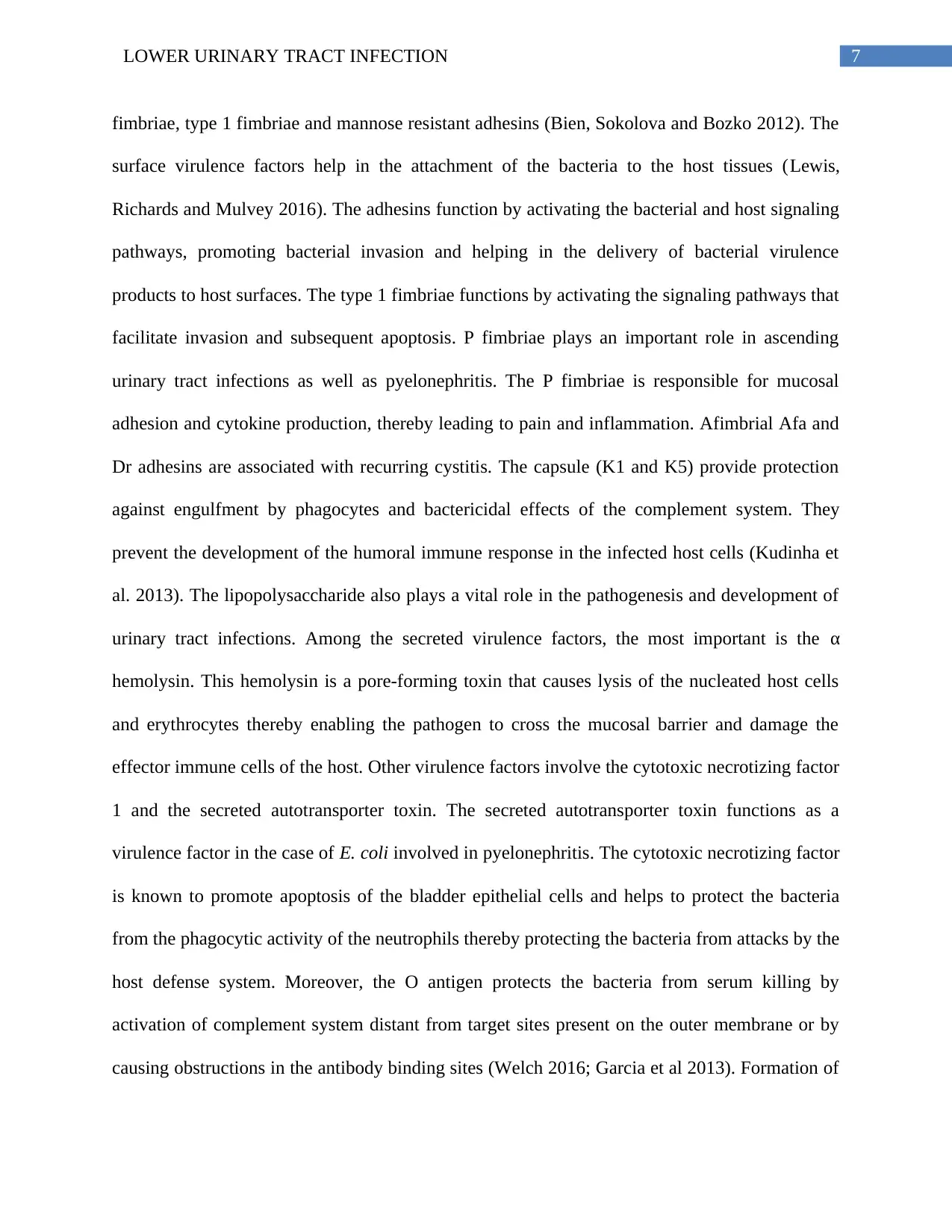
7LOWER URINARY TRACT INFECTION
fimbriae, type 1 fimbriae and mannose resistant adhesins (Bien, Sokolova and Bozko 2012). The
surface virulence factors help in the attachment of the bacteria to the host tissues (Lewis,
Richards and Mulvey 2016). The adhesins function by activating the bacterial and host signaling
pathways, promoting bacterial invasion and helping in the delivery of bacterial virulence
products to host surfaces. The type 1 fimbriae functions by activating the signaling pathways that
facilitate invasion and subsequent apoptosis. P fimbriae plays an important role in ascending
urinary tract infections as well as pyelonephritis. The P fimbriae is responsible for mucosal
adhesion and cytokine production, thereby leading to pain and inflammation. Afimbrial Afa and
Dr adhesins are associated with recurring cystitis. The capsule (K1 and K5) provide protection
against engulfment by phagocytes and bactericidal effects of the complement system. They
prevent the development of the humoral immune response in the infected host cells (Kudinha et
al. 2013). The lipopolysaccharide also plays a vital role in the pathogenesis and development of
urinary tract infections. Among the secreted virulence factors, the most important is the α
hemolysin. This hemolysin is a pore-forming toxin that causes lysis of the nucleated host cells
and erythrocytes thereby enabling the pathogen to cross the mucosal barrier and damage the
effector immune cells of the host. Other virulence factors involve the cytotoxic necrotizing factor
1 and the secreted autotransporter toxin. The secreted autotransporter toxin functions as a
virulence factor in the case of E. coli involved in pyelonephritis. The cytotoxic necrotizing factor
is known to promote apoptosis of the bladder epithelial cells and helps to protect the bacteria
from the phagocytic activity of the neutrophils thereby protecting the bacteria from attacks by the
host defense system. Moreover, the O antigen protects the bacteria from serum killing by
activation of complement system distant from target sites present on the outer membrane or by
causing obstructions in the antibody binding sites (Welch 2016; Garcia et al 2013). Formation of
fimbriae, type 1 fimbriae and mannose resistant adhesins (Bien, Sokolova and Bozko 2012). The
surface virulence factors help in the attachment of the bacteria to the host tissues (Lewis,
Richards and Mulvey 2016). The adhesins function by activating the bacterial and host signaling
pathways, promoting bacterial invasion and helping in the delivery of bacterial virulence
products to host surfaces. The type 1 fimbriae functions by activating the signaling pathways that
facilitate invasion and subsequent apoptosis. P fimbriae plays an important role in ascending
urinary tract infections as well as pyelonephritis. The P fimbriae is responsible for mucosal
adhesion and cytokine production, thereby leading to pain and inflammation. Afimbrial Afa and
Dr adhesins are associated with recurring cystitis. The capsule (K1 and K5) provide protection
against engulfment by phagocytes and bactericidal effects of the complement system. They
prevent the development of the humoral immune response in the infected host cells (Kudinha et
al. 2013). The lipopolysaccharide also plays a vital role in the pathogenesis and development of
urinary tract infections. Among the secreted virulence factors, the most important is the α
hemolysin. This hemolysin is a pore-forming toxin that causes lysis of the nucleated host cells
and erythrocytes thereby enabling the pathogen to cross the mucosal barrier and damage the
effector immune cells of the host. Other virulence factors involve the cytotoxic necrotizing factor
1 and the secreted autotransporter toxin. The secreted autotransporter toxin functions as a
virulence factor in the case of E. coli involved in pyelonephritis. The cytotoxic necrotizing factor
is known to promote apoptosis of the bladder epithelial cells and helps to protect the bacteria
from the phagocytic activity of the neutrophils thereby protecting the bacteria from attacks by the
host defense system. Moreover, the O antigen protects the bacteria from serum killing by
activation of complement system distant from target sites present on the outer membrane or by
causing obstructions in the antibody binding sites (Welch 2016; Garcia et al 2013). Formation of
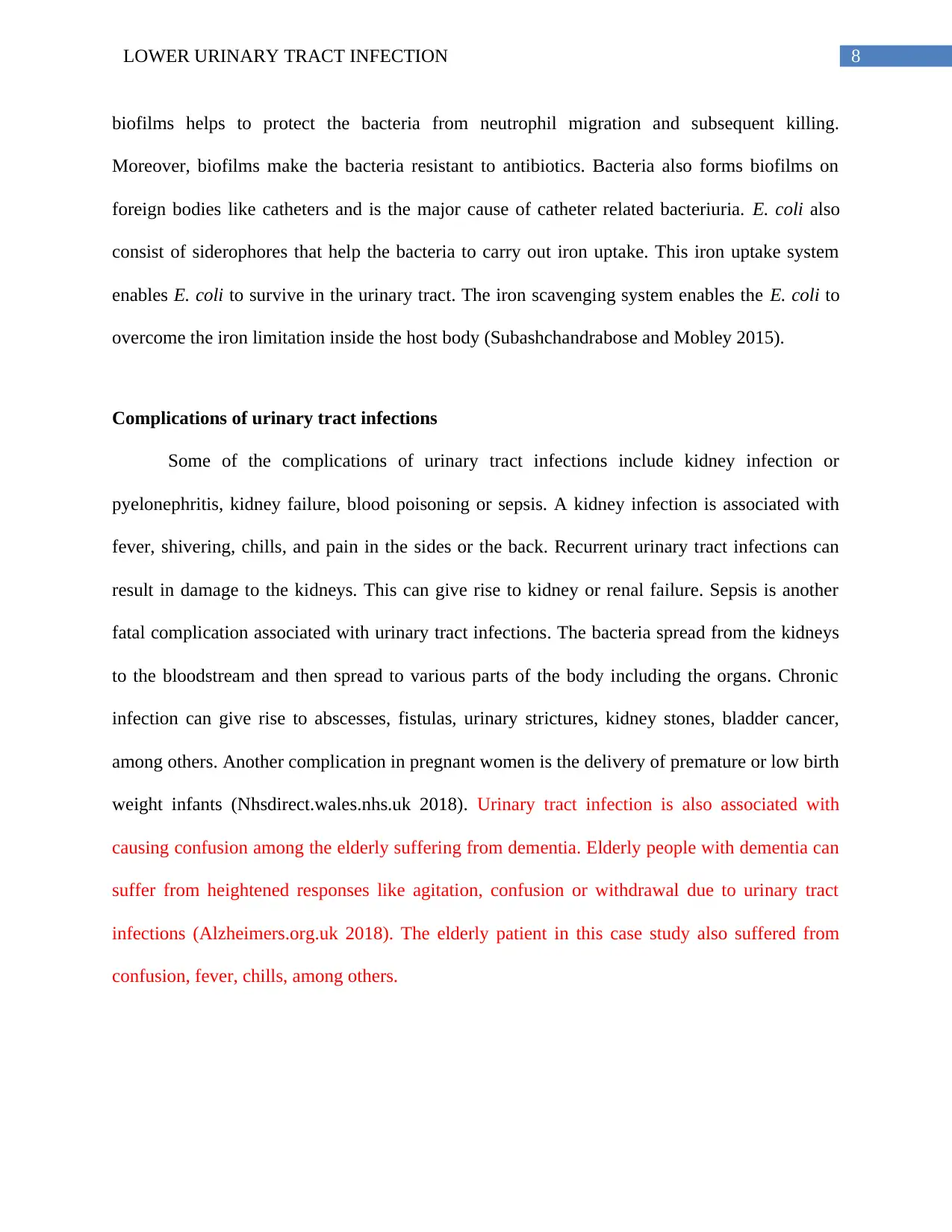
8LOWER URINARY TRACT INFECTION
biofilms helps to protect the bacteria from neutrophil migration and subsequent killing.
Moreover, biofilms make the bacteria resistant to antibiotics. Bacteria also forms biofilms on
foreign bodies like catheters and is the major cause of catheter related bacteriuria. E. coli also
consist of siderophores that help the bacteria to carry out iron uptake. This iron uptake system
enables E. coli to survive in the urinary tract. The iron scavenging system enables the E. coli to
overcome the iron limitation inside the host body (Subashchandrabose and Mobley 2015).
Complications of urinary tract infections
Some of the complications of urinary tract infections include kidney infection or
pyelonephritis, kidney failure, blood poisoning or sepsis. A kidney infection is associated with
fever, shivering, chills, and pain in the sides or the back. Recurrent urinary tract infections can
result in damage to the kidneys. This can give rise to kidney or renal failure. Sepsis is another
fatal complication associated with urinary tract infections. The bacteria spread from the kidneys
to the bloodstream and then spread to various parts of the body including the organs. Chronic
infection can give rise to abscesses, fistulas, urinary strictures, kidney stones, bladder cancer,
among others. Another complication in pregnant women is the delivery of premature or low birth
weight infants (Nhsdirect.wales.nhs.uk 2018). Urinary tract infection is also associated with
causing confusion among the elderly suffering from dementia. Elderly people with dementia can
suffer from heightened responses like agitation, confusion or withdrawal due to urinary tract
infections (Alzheimers.org.uk 2018). The elderly patient in this case study also suffered from
confusion, fever, chills, among others.
biofilms helps to protect the bacteria from neutrophil migration and subsequent killing.
Moreover, biofilms make the bacteria resistant to antibiotics. Bacteria also forms biofilms on
foreign bodies like catheters and is the major cause of catheter related bacteriuria. E. coli also
consist of siderophores that help the bacteria to carry out iron uptake. This iron uptake system
enables E. coli to survive in the urinary tract. The iron scavenging system enables the E. coli to
overcome the iron limitation inside the host body (Subashchandrabose and Mobley 2015).
Complications of urinary tract infections
Some of the complications of urinary tract infections include kidney infection or
pyelonephritis, kidney failure, blood poisoning or sepsis. A kidney infection is associated with
fever, shivering, chills, and pain in the sides or the back. Recurrent urinary tract infections can
result in damage to the kidneys. This can give rise to kidney or renal failure. Sepsis is another
fatal complication associated with urinary tract infections. The bacteria spread from the kidneys
to the bloodstream and then spread to various parts of the body including the organs. Chronic
infection can give rise to abscesses, fistulas, urinary strictures, kidney stones, bladder cancer,
among others. Another complication in pregnant women is the delivery of premature or low birth
weight infants (Nhsdirect.wales.nhs.uk 2018). Urinary tract infection is also associated with
causing confusion among the elderly suffering from dementia. Elderly people with dementia can
suffer from heightened responses like agitation, confusion or withdrawal due to urinary tract
infections (Alzheimers.org.uk 2018). The elderly patient in this case study also suffered from
confusion, fever, chills, among others.
⊘ This is a preview!⊘
Do you want full access?
Subscribe today to unlock all pages.

Trusted by 1+ million students worldwide

9LOWER URINARY TRACT INFECTION
Nursing care for urinary tract infections
The nursing diagnosis for urinary tract infections include impaired urinary elimination,
acute pain, infection, hyperthermia, disturbed sleep and deficient knowledge (Silva et al. 2017).
Impaired urine elimination is associated with dysuria, increased urine frequency, urgency or
hesitancy (Zatorski et al. 2016). The patient in this case study suffers from dysuria as well as
increased urine frequency and urgency. The desired nursing outcomes would be to achieve
normal patterns of urine elimination and absence of symptoms of dysuria like pain and
discomfort. The nursing interventions include assessment of the patient’s urine elimination
pattern, recording the client’s gender and age, palpating the patient’s bladder to determine if
urinary retention is present, promoting increased fluid uptake to increase the renal blood flow,
promoting frequent voiding in order to prevent urine accumulation, use of Mandelamine and
vitamin C in order to maintain an acidic pH in the bladder thereby preventing the growth of
bacteria (Lockwood 2017). The second nursing diagnosis is infection and is associated with
bacteriuria, burning sensation during urination, fatigue, fever, flank pain, offensive odor,
hematuria, suprapubic tenderness, increase in the number of white blood cells, increased urine
frequency, cognitive impairment in older adults, anorexia, among others (Cortes-Penfield,
Trautner and Jump 2017). The patient in the case study also suffers from bacteriuria, hematuria,
feels a burning sensation and discomfort during urine, has a bad odor in the urine and also shows
signs of confusion, which could be due to cognitive impairment. The nursing interventions
would be to assess the signs and symptoms as well as the risk factors, monitoring white blood
cell count, urinalysis, bacterial count, urine culture and antibiotic sensitivity (Doern and
Richardson 2016). Other nursing interventions would be to drink cranberry juice that prevents or
reduces the bacterial adherence, use of vitamin C, promote regular voiding, antibiotic therapy
Nursing care for urinary tract infections
The nursing diagnosis for urinary tract infections include impaired urinary elimination,
acute pain, infection, hyperthermia, disturbed sleep and deficient knowledge (Silva et al. 2017).
Impaired urine elimination is associated with dysuria, increased urine frequency, urgency or
hesitancy (Zatorski et al. 2016). The patient in this case study suffers from dysuria as well as
increased urine frequency and urgency. The desired nursing outcomes would be to achieve
normal patterns of urine elimination and absence of symptoms of dysuria like pain and
discomfort. The nursing interventions include assessment of the patient’s urine elimination
pattern, recording the client’s gender and age, palpating the patient’s bladder to determine if
urinary retention is present, promoting increased fluid uptake to increase the renal blood flow,
promoting frequent voiding in order to prevent urine accumulation, use of Mandelamine and
vitamin C in order to maintain an acidic pH in the bladder thereby preventing the growth of
bacteria (Lockwood 2017). The second nursing diagnosis is infection and is associated with
bacteriuria, burning sensation during urination, fatigue, fever, flank pain, offensive odor,
hematuria, suprapubic tenderness, increase in the number of white blood cells, increased urine
frequency, cognitive impairment in older adults, anorexia, among others (Cortes-Penfield,
Trautner and Jump 2017). The patient in the case study also suffers from bacteriuria, hematuria,
feels a burning sensation and discomfort during urine, has a bad odor in the urine and also shows
signs of confusion, which could be due to cognitive impairment. The nursing interventions
would be to assess the signs and symptoms as well as the risk factors, monitoring white blood
cell count, urinalysis, bacterial count, urine culture and antibiotic sensitivity (Doern and
Richardson 2016). Other nursing interventions would be to drink cranberry juice that prevents or
reduces the bacterial adherence, use of vitamin C, promote regular voiding, antibiotic therapy
Paraphrase This Document
Need a fresh take? Get an instant paraphrase of this document with our AI Paraphraser
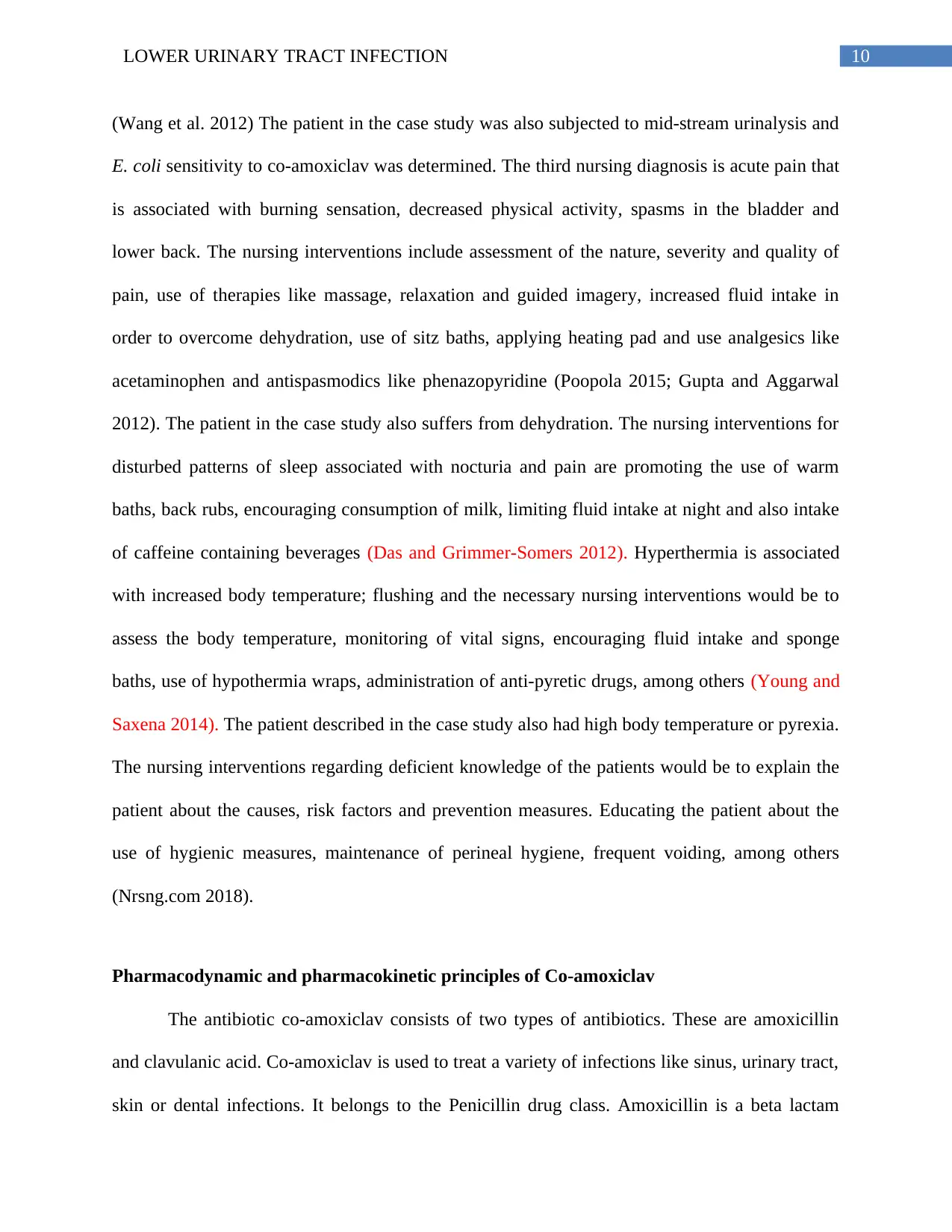
10LOWER URINARY TRACT INFECTION
(Wang et al. 2012) The patient in the case study was also subjected to mid-stream urinalysis and
E. coli sensitivity to co-amoxiclav was determined. The third nursing diagnosis is acute pain that
is associated with burning sensation, decreased physical activity, spasms in the bladder and
lower back. The nursing interventions include assessment of the nature, severity and quality of
pain, use of therapies like massage, relaxation and guided imagery, increased fluid intake in
order to overcome dehydration, use of sitz baths, applying heating pad and use analgesics like
acetaminophen and antispasmodics like phenazopyridine (Poopola 2015; Gupta and Aggarwal
2012). The patient in the case study also suffers from dehydration. The nursing interventions for
disturbed patterns of sleep associated with nocturia and pain are promoting the use of warm
baths, back rubs, encouraging consumption of milk, limiting fluid intake at night and also intake
of caffeine containing beverages (Das and Grimmer-Somers 2012). Hyperthermia is associated
with increased body temperature; flushing and the necessary nursing interventions would be to
assess the body temperature, monitoring of vital signs, encouraging fluid intake and sponge
baths, use of hypothermia wraps, administration of anti-pyretic drugs, among others (Young and
Saxena 2014). The patient described in the case study also had high body temperature or pyrexia.
The nursing interventions regarding deficient knowledge of the patients would be to explain the
patient about the causes, risk factors and prevention measures. Educating the patient about the
use of hygienic measures, maintenance of perineal hygiene, frequent voiding, among others
(Nrsng.com 2018).
Pharmacodynamic and pharmacokinetic principles of Co-amoxiclav
The antibiotic co-amoxiclav consists of two types of antibiotics. These are amoxicillin
and clavulanic acid. Co-amoxiclav is used to treat a variety of infections like sinus, urinary tract,
skin or dental infections. It belongs to the Penicillin drug class. Amoxicillin is a beta lactam
(Wang et al. 2012) The patient in the case study was also subjected to mid-stream urinalysis and
E. coli sensitivity to co-amoxiclav was determined. The third nursing diagnosis is acute pain that
is associated with burning sensation, decreased physical activity, spasms in the bladder and
lower back. The nursing interventions include assessment of the nature, severity and quality of
pain, use of therapies like massage, relaxation and guided imagery, increased fluid intake in
order to overcome dehydration, use of sitz baths, applying heating pad and use analgesics like
acetaminophen and antispasmodics like phenazopyridine (Poopola 2015; Gupta and Aggarwal
2012). The patient in the case study also suffers from dehydration. The nursing interventions for
disturbed patterns of sleep associated with nocturia and pain are promoting the use of warm
baths, back rubs, encouraging consumption of milk, limiting fluid intake at night and also intake
of caffeine containing beverages (Das and Grimmer-Somers 2012). Hyperthermia is associated
with increased body temperature; flushing and the necessary nursing interventions would be to
assess the body temperature, monitoring of vital signs, encouraging fluid intake and sponge
baths, use of hypothermia wraps, administration of anti-pyretic drugs, among others (Young and
Saxena 2014). The patient described in the case study also had high body temperature or pyrexia.
The nursing interventions regarding deficient knowledge of the patients would be to explain the
patient about the causes, risk factors and prevention measures. Educating the patient about the
use of hygienic measures, maintenance of perineal hygiene, frequent voiding, among others
(Nrsng.com 2018).
Pharmacodynamic and pharmacokinetic principles of Co-amoxiclav
The antibiotic co-amoxiclav consists of two types of antibiotics. These are amoxicillin
and clavulanic acid. Co-amoxiclav is used to treat a variety of infections like sinus, urinary tract,
skin or dental infections. It belongs to the Penicillin drug class. Amoxicillin is a beta lactam

11LOWER URINARY TRACT INFECTION
antibiotic that plays an important role in the inhibition of the enzymes like penicillin binding
proteins, thereby inhibiting the synthesis of peptidoglycan (Worthington and Melander 2013),
which is an important component of the cell wall of bacterial. Cell wall weakening results in cell
lysis, damage and eventual death (Contreras-Martel et al. 2017). Clavulanic acid is another beta
lactam antibiotic that prevents the inactivation of amoxicillin by inactivation of beta lactamase
enzymes (Shaikh et al. 2015). Clavulanic acid does not possess any significant antimicrobial
properties when used alone (Mhra.gov.uk 2018). The pharmacokinetic properties of co-
amoxiclav include absorption, distribution, biotransformation and elimination. Both amoxicillin
and clavulanic acid undergoes full disassociation under physiological pH in aqueous solutions
(Thambavita et al. 2017). They are readily absorbed by the oral administration route. Optimum
absorption of amoxicillin and clavulanic acid occurs, when taken before meals
(Dailymed.nlm.nih.gov 2018). Following absorption, 18% of the total plasma amoxicillin
remains bound to proteins while 25% of total plasma clavulanic acid remains bound to proteins
(De Cock et al. 2015). Amoxicillin provides an advantage with regards to other beta lactam
antibiotics as it has a greater oral bio-availability. The distribution volume is 0.3-0.4l/kg in case
of amoxicillin and 0.2l/kg in case of clavulanic acid. Intravenous administration of amoxicillin
and clavulanic acid results in their accumulation or distribution in the gall bladder, skin, fat,
synovial or peritoneal fluids, bile, muscle tissue (Medsafe.gov.nz 2018), among others. They are
also known to cross the placental barrier (Medicines.org.uk 2018). Amoxicillin undergoes
biotransformation to inactive penicilloic acid and gets excreted in the urine. Clavulanic acid also
undergoes extensive metabolism and gets excreted along with urine and stools (Mhra.gov.uk
2018). Moreover, it can also be excreted in the form of carbon dioxide in air (Medicines.org.uk
2018). The main route of elimination is the kidney in case of amoxicillin, while clavulanic acid
antibiotic that plays an important role in the inhibition of the enzymes like penicillin binding
proteins, thereby inhibiting the synthesis of peptidoglycan (Worthington and Melander 2013),
which is an important component of the cell wall of bacterial. Cell wall weakening results in cell
lysis, damage and eventual death (Contreras-Martel et al. 2017). Clavulanic acid is another beta
lactam antibiotic that prevents the inactivation of amoxicillin by inactivation of beta lactamase
enzymes (Shaikh et al. 2015). Clavulanic acid does not possess any significant antimicrobial
properties when used alone (Mhra.gov.uk 2018). The pharmacokinetic properties of co-
amoxiclav include absorption, distribution, biotransformation and elimination. Both amoxicillin
and clavulanic acid undergoes full disassociation under physiological pH in aqueous solutions
(Thambavita et al. 2017). They are readily absorbed by the oral administration route. Optimum
absorption of amoxicillin and clavulanic acid occurs, when taken before meals
(Dailymed.nlm.nih.gov 2018). Following absorption, 18% of the total plasma amoxicillin
remains bound to proteins while 25% of total plasma clavulanic acid remains bound to proteins
(De Cock et al. 2015). Amoxicillin provides an advantage with regards to other beta lactam
antibiotics as it has a greater oral bio-availability. The distribution volume is 0.3-0.4l/kg in case
of amoxicillin and 0.2l/kg in case of clavulanic acid. Intravenous administration of amoxicillin
and clavulanic acid results in their accumulation or distribution in the gall bladder, skin, fat,
synovial or peritoneal fluids, bile, muscle tissue (Medsafe.gov.nz 2018), among others. They are
also known to cross the placental barrier (Medicines.org.uk 2018). Amoxicillin undergoes
biotransformation to inactive penicilloic acid and gets excreted in the urine. Clavulanic acid also
undergoes extensive metabolism and gets excreted along with urine and stools (Mhra.gov.uk
2018). Moreover, it can also be excreted in the form of carbon dioxide in air (Medicines.org.uk
2018). The main route of elimination is the kidney in case of amoxicillin, while clavulanic acid
⊘ This is a preview!⊘
Do you want full access?
Subscribe today to unlock all pages.

Trusted by 1+ million students worldwide
1 out of 25
Related Documents
Your All-in-One AI-Powered Toolkit for Academic Success.
+13062052269
info@desklib.com
Available 24*7 on WhatsApp / Email
![[object Object]](/_next/static/media/star-bottom.7253800d.svg)
Unlock your academic potential
Copyright © 2020–2025 A2Z Services. All Rights Reserved. Developed and managed by ZUCOL.




